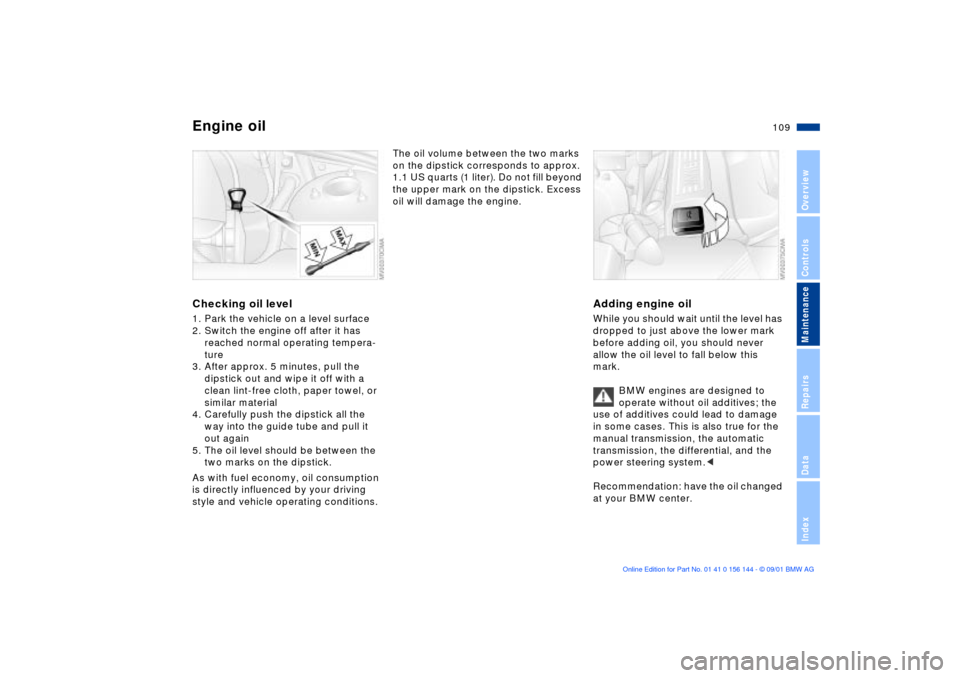2002 BMW 330Ci COUPE power steering
[x] Cancel search: power steeringPage 4 of 147

Contents
© 2001 Bayerische Motoren Werke
Aktiengesellschaft
Munich, Germany
Reprinting, including excerpts, only with the
written consent of BMW AG, Munich.
Order No. 01 40 0 156 144
deutsch VIII/01
Printed in Germany
Printed on environmentally friendly paper
(bleached without chlorine, suitable for recycling).
Overview
Controls and features
Cockpit14
Instrument cluster15
Indicator and warning lamps17
Multifunction steering wheel
(MFL)21
Hazard warning triangle22
Refueling22
Fuel specifications23
Tire inflation pressures24
Opening and closing:
Keys28
Central locking system28
Opening and closing Ð via the
remote control29
Opening and closing Ð via the
door lock31
Opening and closing Ð from the
inside32
Luggage compartment lid33
Luggage compartment35
Alarm system36
Electric power windows37
Sliding/tilt sunroof38
Adjustments:
Correct sitting posture40
Seats40
Manual seat adjustment41
Power seat adjustment42
Lumbar support42
Head restraints43
Entering the rear43
Safety belts44
Seat and mirror memory45
Seat heating46
Steering wheel46
Mirrors47
Passenger safety systems:
Airbags48
Transporting children safely51
Vehicle Memory, Key
Memory53
Driving:
Ignition lock54
Starting the engine54
Switching off the engine55
Parking brake56
Manual transmission56
Automatic transmission with
Steptronic57
Indicator/Headlamp flasher59
Washer/Wiper system/Rain
sensor60
Cruise control62
Everything under control:
Odometer64
Tachometer64
Energy control64
Fuel gauge65
Temperature gauge65
Service Interval Display65
Check Control66
Computer66
Technology for safety and
driving convenience:
Park Distance Control (PDC)69
Automatic Stability Control plus
Traction (ASC+T)70
Dynamic Stability Control
(DSC)71
Tire Pressure Monitor (RDC)73
Flat Tire Monitor75
Contents
Page 40 of 147

40n
Correct sitting posture SeatsFor relaxed and fatigue-free driving you
should select a sitting position that
reflects your personal requirements.
Correct posture combines with safety
belts and airbags to enhance occupant
safety in the event of an accident. To
ensure that the vehicle's safety systems
provide you with optimal protection, we
request that you direct your careful
attention to the following section.
For supplementary information on
transporting children, refer to page 51. Sitting correctly with airbags
Always maintain an adequate
distance between yourself and the
airbags. Always hold the steering wheel
by the rim to keep any chance of injury
to hands or arms to an absolute
minimum should the airbag be
deployed. Never allow any objects,
individuals or animals to obstruct the
areas between passengers and airbags.
Never use the front airbag's cover as a
storage tray or support for objects of
any kind. Never allow front passengers
to rest their feet or legs on the airbag
cover.<
For airbag locations and additional
information on airbags, refer to
page 48.
Safe with safety belts
Never allow more than one person
to wear a single safety belt. Never
allow infants or small children to ride in
a passenger's lap. Avoid twisting the
belt while routing it firmly across the
pelvis and shoulder, wear it as snugly
against your body as possible. Do not
allow the belt to rest against hard or
fragile objects in your pockets. Do not
route the belt across your neck, or run it
across sharp edges. Be sure that the
belt does not become caught or
jammed. Avoid wearing bulky clothing
and pull on the lap belt periodically to
retension it over your shoulders. In the
event of a frontal impact, a loose lap
belt could slide over the hips, leading to
abdominal injury. In addition, the safety
belt's restraint effectiveness is reduced
if it is worn loosely. Expectant mothers
should always wear their safety belts,
taking care to position the lap belt
against the lower hips, where it will not
exert pressure against the abdominal
area.<
For information on using the safety
belts, refer to page 44.
When adjusting your seat, always
observe the following precautions
Never try to adjust your seat while
operating the vehicle. The seat
could respond with an unexpected
movement, and the ensuing loss of
vehicle control could lead to an acci-
dent. Never ride with the backrest
reclined to an extreme horizontal angle
(important for front passengers to
remember). Keep the backrest relatively
upright to minimize the risk of sliding
under the safety belt and sustaining
injury in an accident.<
Seat adjustment>Manual seat adjustment, refer to
page 41
>Power seat adjustment, refer to
page 42
>Head restraint, refer to page 43
>Entering the rear, refer to page 43
Page 100 of 147

100n
Brake systemBrake fluid level If the brake fluid level is too low and
brake pedal travel has become longer,
there may be a defect in one of the
brake system's hydraulic circuits.
Proceed to the nearest BMW
center. It may be necessary to
apply higher levels of pressure to the
pedal when stopping and braking
distances may also be longer. Please
remember to adapt your driving style
accordingly.
and operating conditions in which
braking is restricted to gentle, low-
pressure applications will all increase
the tendency for corrosion to form on
the rotors; this is often accompanied by
a simultaneous accumulation of
contamination on the brake pads. The
pads must exert a certain minimal level
of pressure against the rotors for the
disc brakes' inherent self-cleaning
effect to remain effective; the pressure
available under the above conditions
may not provide adequate cleansing.
If the brake rotors are corroded, they
will tend to respond to braking with a
pulsating effect that even extended
brake applications will fail to cure.
When driving in heavy rain and on wet
roads it is a good idea to apply light
pressure to the brake pedal every few
miles. Monitor traffic conditions to
ensure that this maneuver does not
pose a hazard to you or to other road
users. The heat generated in this
process helps dry the pads and rotors
to ensure that your brake system will
respond with undiminished efficiency
when you need it.
When descending steep hills and
extended grades, downshift to a gear
that will allow you to continue safely
with only a minimal amount of braking.
By minimizing the loads placed on the
brake system, this strategy helps
ensure that optimal brake system
response will remain available at all
times. Use care to avoid exceeding the
approved engine-speed range, refer to
page 64.Do not coast with the clutch
depressed or with the transmis-
sion or selector lever in Neutral. Do not
coast with the engine shut off. The
engine provides no braking effect when
the clutch is depressed and there is no
power-assist for braking or steering
when the engine is not running.
Never allow floor mats, carpets or any
other objects to protrude into the area
around the accelerator, clutch and
brake pedals and obstruct their move-
ment.<
Brake pads
For your own safety: use only
brake pads that the manufacturer
has released for your particular vehicle
model. The manufacturer cannot eval-
uate non-approved brake pads to
determine if they are suited for use, and
therefore cannot ensure the operating
safety of the vehicle if they are
installed.<
Page 109 of 147

109n
OverviewControlsMaintenanceRepairsDataIndex
Engine oilChecking oil level1. Park the vehicle on a level surface
2. Switch the engine off after it has
reached normal operating tempera-
ture
3. After approx. 5 minutes, pull the
dipstick out and wipe it off with a
clean lint-free cloth, paper towel, or
similar material
4. Carefully push the dipstick all the
way into the guide tube and pull it
out again
5. The oil level should be between the
two marks on the dipstick.
As with fuel economy, oil consumption
is directly influenced by your driving
style and vehicle operating conditions.
The oil volume between the two marks
on the dipstick corresponds to approx.
1.1 US quarts (1 liter). Do not fill beyond
the upper mark on the dipstick. Excess
oil will damage the engine.
Adding engine oilWhile you should wait until the level has
dropped to just above the lower mark
before adding oil, you should never
allow the oil level to fall below this
mark.
BMW engines are designed to
operate without oil additives; the
use of additives could lead to damage
in some cases. This is also true for the
manual transmission, the automatic
transmission, the differential, and the
power steering system.<
Recommendation: have the oil changed
at your BMW center.
Page 138 of 147

Everything from A to ZA
ABS (Antilock Brake
System)19, 99
Acceleration traction control,
refer to DSC71
Accessories10
Activated-charcoal filter86
Adaptive Transmission
Control (ATC)58
ADB (Automatic Differential
Brake)71
Adding
brake fluid112
coolant111
engine oil109
washer fluid108
Adjusting
head restraints43
lumbar support42
manual seat41
power seat42
steering wheel46
thigh support41
Air conditioning80
temperature settings81
Air distribution81, 84 Air nozzles80, 83
Air outlets80, 83
ventilation80
Air supply81, 84
Airbags18, 48
sitting correctly40
Alarm system36
Antifreeze111
radiator111
Antilock Brake System
(ABS)19, 99
Anti-theft system36
Aquaplaning99
Armrest87
ASC+T (Automatic Stability
Control plus Traction)70
Ashtray
front89
rear90
ATC (Adaptive Transmission
Control)58
Attach vehicle vacuum
cleaner89
AUC (Automatic
recirculated-air
control)85
Automatic climate
control83
temperature settings84 Automatic cruise control62
Automatic Differential Brake
(ADB)71
Automatic headlight
control77
Automatic recirculated-air
control (AUC)85
Automatic Stability Control
plus Traction (ASC+T)70
Automatic transmission57
Automatic transmission with
Steptronic18, 57
Automatic-dimming inside
rearview mirror48
Average consumption68
Average speed68
Axle loads134
B
Backrest
adjusting41
releasing43
Backup lamps56
bulb replacement121
Battery127
charge current indicator
lamp17
charging127 Beverage holder88
Blower81, 84
BMW High Performance
Synthetic Oil110
BMW Maintenance
System113
BMW sports seat
manual adjustment41
power adjustment42
Bore132
Bottle holder, refer to
beverage holder88
Brake fluid112
Brake hydraulic system17
Brake lamps
bulb replacement121
Brake system100
brake fluid level100
brake pads100
brake pads, indicator19
disc brakes100
Brake system, brake
malfunction100
Break-in procedure98
Bulbs and lamps,
replacement118
A-Z
Page 143 of 147

Everything from A to Z
143n
OverviewControlsMaintenancRepairsDataIndex
Selector lever, automatic
transmission57
Service and Warranty
Information Booklet (US
models)113
Service Interval
Display65, 113
Setting temperature81
Shiftlock57
Side airbags48
Side Impact Head Protection
System48
Ski bag92
Sliding/tilt sunroof38
electrical malfunction39
manual operation39
Snow chains105
Socket89
Sound system86
Space-saver spare
tire25, 123
Spare key28
Spare tire123
Speedometer15
Sport steering wheel21
Sports seat
manual adjustment41
power adjustment42 Standing lamps78
Starting the engine54
Steering wheel46
Steering wheel lock54
Stopping the vehicle55
Storage compartments87
Stowing cargo93
Stroke132
Sun blind cover86
Switching off the engine55
Switching off the interior
motion sensor37
Switching off the tilt alarm
sensor37
Symbols8
Synthetic oils110
T
Tachometer64
Tail lamps
bulb replacement121
Tank capacity135
Technical data132
Technical
modifications10, 114
Telephone preparation89
Temperature display
outside temperature67 Temperature gauge
engine coolant65
Temperature
layering82, 85
Thigh support
adjustment41
Third brake light122
Through-loading system91
Tilt alarm sensor30, 37
remote control30
switching off37
Tire change123
Tire condition101
Tire damage101
Tire inflation
pressures24, 101
monitoring73
table25
Tire Pressure Monitor
(RDC)73, 103, 126
Tire pressure warning73
Tire Quality Grading103
Tire replacement102
Tire tread101
Tires and wheels101
Tool kit118
Torque132
Towing fittings129 Towing the vehicle129
Track133
Transmission56
Transmitter keys28
Transporting children
safely51
Tread depth, tires101
Tread Wear Indicator101
Trip odometer64
Trunk lid, refer to luggage
compartment lid33
Trunk, refer to luggage
compartment35
Turn signal
indicator20, 59, 120
bulb replacement120
Turning radius133
U
Uniform Tire Quality
Grading103